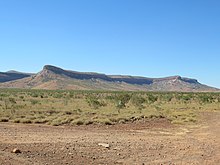







A mesa is an isolated, flat-topped elevation, ridge or hill, which is bounded from all sides by steep escarpments and stands distinctly above a surrounding plain. Mesas characteristically consist of flat-lying soft sedimentary rocks capped by a more resistant layer or layers of harder rock, e.g. shales overlain by sandstones. The resistant layer acts as a caprock that forms the flat summit of a mesa. The caprock can consist of either sedimentary rocks such as sandstone and limestone; dissected lava flows; or a deeply eroded duricrust. Unlike plateau, whose usage does not imply horizontal layers of bedrock, e.g. Tibetan Plateau, the term mesa applies exclusively to the landforms built of flat-lying strata. Instead, flat-topped plateaus are specifically known as tablelands.[1][2][3]
- '^ Duszyński, F., Migoń, P. and Strzelecki, M.C., 2019. Escarpment retreat in sedimentary tablelands and cuesta landscapes–Landforms, mechanisms and patterns. Earth-Science Reviews, no. 102890. doi.org/10.1016/j.earscirev.2019.102890
- ^ Migoń, P., 2004a. Mesa. In: Goudie, A.S. (Ed.), Encyclopedia of Geomorphology. Routledge, London, pp. 668. ISBN 9780415272988
- ^ Neuendorf, Klaus K.E. Mehl, James P., Jr. Jackson, Julia A.. (2011). Glossary of Geology (5th Edition). American Geosciences Institute. ISBN 9781680151787